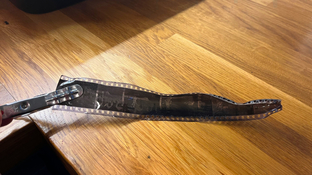Sirius is right.
I couldn't get it to melt off.
But I did get wild twisty curling when I dipped in acetone/alcohol and dried in heat.
That's what I think happened to the whole cabinet of film.
Where did the acetone idea come from? I've not heard of that before. And which alcohol did you use?
In my youth (spent in a school close to Fleet Street), press photographers sometimes dried
prints by dipping in methanol and lighting it. This allowed prints to be rushed in-house to the layout team or sent urgently (by teleprinter, I think) to London from remote parts of the world. I tried this drying method, and it worked nicely, with single-weight paper. Meths burns at quite a low temperature, so at a pinch (excuse pun) you can hold the print between thumb and forefinger while the meths burns off, and you won't get serious burns even if your fingers are also wet with meths. No suggestion of the emulsion shifting off the paper, but the edges could be a little smoky, and I did drop a few prints to burn themselves out on the darkroom floor, between me and the only exit.

Still, the floor was concrete, and a meths flame is easily extinguished.
Ethanol, propanol, or an acetone/alcohol mix, would presumably burn hotter than meths alone. So I doubt either would be suited for this incendiary technique, although they may speed up air-drying. Others have already mentioned drying cabinets, which were little more than tall steel lockers with rails at the top and a heat source down below. Films were hung with clips top and bottom to prevent curling. I've seen photos of loaded cabinets with no bottom clips, but I'm not surprised that your single negative curled up when heated, Bill.
But I also know that in an urgent situation prints were sometimes made in newspaper darkrooms from negatives that were still wet. The uncut film was shoved straight into the enlarger, with the rolled ends of the film supported by those funny curved wings that all enlargers used to have. I imagine this scratched the hell out of the negatives, but it was all about selling the day's newspaper, not about building a historical archive. My point is that there was really no need to get Capa's negatives dry, if speed was of the S (to quote PG Wodehouse).
If any darkroom newbie had been in doubt how to dry Capa's negatives quickly, I reckon meths and a cigarette lighter would have come to mind first. So I'm quite intrigued about what happens to wet film dipped in meths (alone) and set on fire. I don't seem to have any meths in the cupboard, otherwise I would try it straight away. But I am going shopping later ...




 Still, the floor was concrete, and a meths flame is easily extinguished.
Still, the floor was concrete, and a meths flame is easily extinguished.

